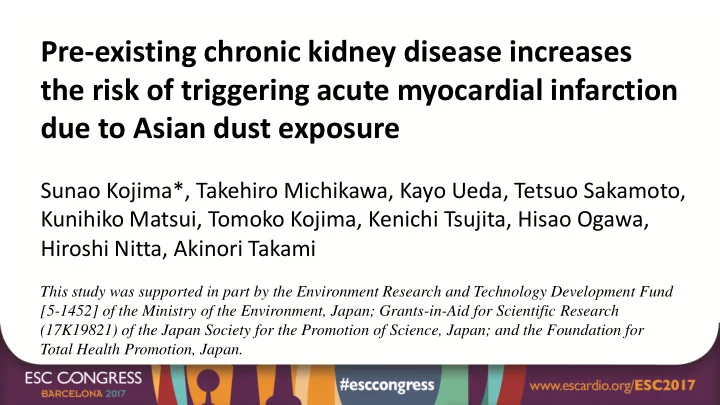

Pre-existing chronic kidney disease increases the risk of triggering acute myocardial infarction due to Asian dust exposure Sunao Kojima*, Takehiro Michikawa, Kayo Ueda, Tetsuo Sakamoto, Kunihiko Matsui, Tomoko Kojima, Kenichi Tsujita, Hisao Ogawa, Hiroshi Nitta, Akinori Takami This study was supported in part by the Environment Research and Technology Development Fund [5-1452] of the Ministry of the Environment, Japan; Grants-in-Aid for Scientific Research (17K19821) of the Japan Society for the Promotion of Science, Japan; and the Foundation for Total Health Promotion, Japan.
Declaration of Interest • Affiliation of Joint Research Teijin Home Healthcare, Limited • Grant Philips Respironics GK
Background • Windblown sand dust originating from mineral soil in the deserts of China and East Asia is known as Asian dust and gives a poetic touch to spring in Japan. • However, Asian dust has recently become a serious health care concern. (Hashizume M, et al. Nihon Eiseigaku Zasshi 2010) • Because Asian dust mixes with air pollutants during atmospheric transport, it contains harmful chemical species and microbiological materials and was suggested to increase the incidence of respiratory events caused by inflammation. (Mori I, et al. Atmos Environ 2003) (Watanabe M, et al. Allergol Int 2011) (Ichinose T, et al. Arch Environ Contam Toxicol 2008) • There are limited data on Asian dust-induced cardiovascular disease (CVD). • Few have explored the differences in the effect of Asian dust exposure on CVDs according to various individual factors.
Purpose and key points about methods • We designed to elucidate the association between Asian dust and the incidence of AMI during a definite period (within days) in a population of patients from a well-defined geographical region, known to have high susceptibility to acute myocardial infarction (AMI). • We previously established the Kumamoto Acute Coronary Events (KACE) study group to accurately examine the incidence of AMI potentially related to Asian dust; specifically, all cases with AMI occurring in Kumamoto Prefecture are registered. • Asian dust, meteorological and air pollutant data were measured and obtained from the Kumamoto Local Meteorological Observatory (KLMO) and Japan Meteorological Agency and these data were available since April 1, 2010. • A time-stratified case-crossover design was applied to examine the association between exposure to Asian dust and AMI risk using KACE study data. • Within-subject comparisons were made between the case period and control periods.
Day 1 Methods 2 .0 OR, 1.45 95%CI, 1.06-1.99 1 .5 OR with 95%CI 1 .0 0 .5 0 .0 Day 0 Day 1 Day 2 Day 3 Day 4 Day 5 Risk for AMI on Asian dust days relative to the incidence of AMI on non-Asian dust days. A great impact of Asian dust on the next-day (Day 1) on incidence of AMI onset
Results Association between Asian dust exposure and next-day onset of acute myocardial infarction, after adjustment for co-pollutant Covariates OR* 95% CI Temperature (Day 0-2) and humidity (Day 0-2) adjusted 1.46 1.09 1.95 Temperature, humidity + PM 2.5 (Day 0-2) adjusted** 1.43 1.06 1.93 Temperature, humidity + NO 2 (Day 0-2) adjusted** 1.46 1.09 1.95 Temperature, humidity + Ox (Day 0-2) adjusted** 1.48 1.11 1.99 Temperature, humidity + SO 2 (Day 0-2) adjusted** 1.46 1.09 1.95 Temperature, humidity + influenza epidemics 1.46 1.09 1.95 *Exposure to Asian dust on Day 0, Day 1, and Days 2-5 were simultaneously entered into the model. **With regard to the association with acute myocardial infarction, the ORs for each 10-unit increase were: 1.00 (95%CI, 1.00 – 1.01) for PM 2.5 ; 1.00 (0.98 – 1.02) for NO 2 ; 1.00 (0.99 – 1.00) for Ox; and 1.00 (0.97 – 1.02) for SO 2 .
P 20 – 65 years (n=1,246) 0.91 Results Age 0.25 65 – 75 years (n=936) >75 years (n=1,531) Men (n=2,675) Sex 0.59 Women (n=1,038) Yes (n=2,680) Hypertension 0.29 No (n=1,033) Diabetes mellitus Yes (n=1,293) 0.39 No (n=2,420) Yes (n=2,105) Dyslipidaemia 0.57 No (n=1,608) Current (n=1,139) Smoking 0.28 Past (n=965) 0.58 Never (n=1,609) Yes (n=1,554) CKD < 0.01 No (n=2,159) 0 1 2 3 4 OR with 95%CI Association between Asian dust and incidence of AMI on Day 1. Data are stratified according to age, sex, and coronary risks.
P=0.02 OR with 95%CI Results 5 Score 0 – 2 4 (OR, 1.12; 95%CI: 0.66-1.91) P=0.09 3 Score 3 – 4 (OR, 1.47; 95%CI: 0.99-2.19) 2 Score 5 – 6 1 (OR, 2.45; 95%CI: 1.14-5.27) 0 Score 0 – 2 Score 3 – 4 Score 5 – 6 (n=1,265) (n=2,006) (n=442) Risk aggregation to predict the incidence of AMI based on the HAMDeNS score
Results • Asian dust is a potential trigger for the onset of AMI in patients exposed to Asian dust in Kumamoto Prefecture. • The incidence of AMI may increase the next day after Asian dust event. • This association may be influenced by several aspects, with renal malfunction among key contributors. • The risk aggregation score may serve as a warning regarding the onset of AMI, especially during Asian dust season.
Conclusions • Asian dust events may lead to AMI and have a great impact on its onset in patients with chronic kidney disease (CKD). • Our results may provide strong evidence to emphasize health education and communication with patients at risk for AMI.
Recommend
More recommend